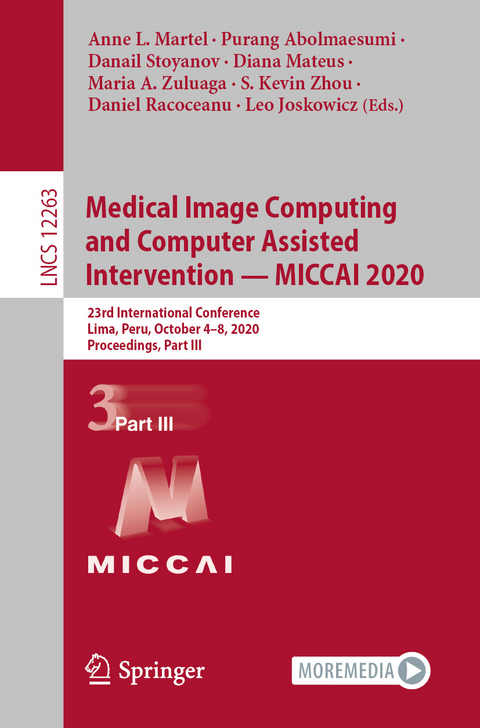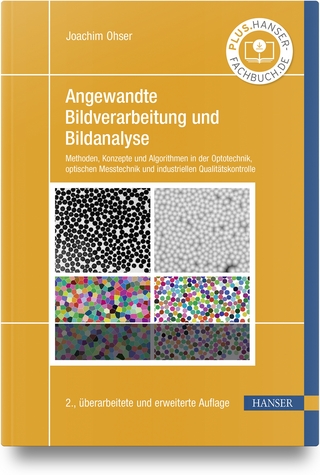
Medical Image Computing and Computer Assisted Intervention – MICCAI 2020
Springer International Publishing (Verlag)
978-3-030-59715-3 (ISBN)
The 542 revised full papers presented were carefully reviewed and selected from 1809 submissions in a double-blind review process. The papers are organized in the following topical sections:
Part I: machine learning methodologies
Part II: image reconstruction; prediction and diagnosis; cross-domain methods and reconstruction; domain adaptation; machine learning applications; generative adversarial networks
Part III: CAI applications; image registration; instrumentation and surgical phase detection; navigation and visualization; ultrasound imaging; video image analysis
Part IV: segmentation; shape models and landmark detection
Part V: biological, optical, microscopic imaging; cell segmentation and stain normalization; histopathology image analysis; opthalmology
Part VI: angiography and vessel analysis; breast imaging; colonoscopy; dermatology; fetal imaging; heart and lung imaging; musculoskeletal imaging
Part VI: brain development and atlases; DWI and tractography; functional brain networks; neuroimaging; positron emission tomography
CAI Applications.- Reconstructing Sinus Anatomy from Endoscopic Video -- Towards a Radiation-free Approach for Quantitative Longitudinal Assessment.- Inertial Measurements for Motion Compensation in Weight-bearing Cone-beam CT of the Knee.- Feasibility check: can audio be a simple alternative to force-based feedback for needle guidance?.- A Graph-Based Method for Optimal Active Electrode Selection in Cochlear Implants.- Improved resection margins in surgical oncology using intraoperative mass spectrometry.- Self-Supervsied Domain Adaptation for Patient-Specific, Real-Time Tissue Tracking.- An Interactive Mixed Reality Platform for Bedside Surgical Procedures.- Ear Cartilage Inference for Reconstructive Surgery with Convolutional Mesh Autoencoders.- Robust Multi-modal 3D Patient Body Modeling.- A New Electromagnetic-Video Endoscope Tracking Method via Anatomical Constraints and Historically Observed Differential Evolution.- Malocclusion Treatment Planning via PointNet based Spatial Transformation Network.- Simulation of Brain Resection for Cavity Segmentation Using Self-Supervised and Semi-Supervised Learning.- Local Contractive Registration for Quantification of Tissue Shrinkage in Assessment of Microwave Ablation.- Reinforcement Learning of Musculoskeletal Control from Functional Simulations.- Image Registration.- MvMM-RegNet: A new image registration framework based on multivariate mixture model and neural network estimation.- Database Annotation with few Examples: An Atlas-based Framework using Diffeomorphic Registration of 3D trees.- Pair-wise and Group-wise Deformation Consistency in Deep Registration Network.- Semantic Hierarchy Guided Registration Networks for Intra-Subject Pulmonary CT Image Alignment.- Highly accurate and memory efficient unsupervised learning-based discrete CT registration using 2.5D displacement search.- Unsupervised Learning Model for Registration of Multi-Phase Ultra-Widefield Fluorescein Angiography.- Large DeformationDiffeomorphic Image Registration with Laplacian Pyramid Networks.- Adversarial Uni- and Multi-modal Stream Networks for Multimodal Image Registration.- Cross-Modality Multi-Atlas Segmentation Using Deep Neural Networks.- Longitudinal Image Registration with Temporal-order and Subject-specificity Discrimination.- Flexible Bayesian Modelling for Nonlinear Image Registration.- Are Registration Uncertainty and Error Monotonically Associated?.- MR-to-US registration using multiclass segmentation of hepatic vasculature with a reduced 3D U-Net.- Detecting Pancreatic Ductal Adenocarcinoma in Multi-phase CT Scans via Alignment Ensemble.- Biomechanics-informed Neural Networks for Myocardial Motion Tracking in MRI.- Fluid registration between lung CT and stationary chest tomosynthesis images.- Anatomical Data Augmentation via Fluid-based Image Registration.- Generliazing Spatial Transformers to Projective Geometry with Applications to 2D/3D Registration.- Instrumentation and Surgical Phase Detection.- TeCNO: Surgical Phase Recognition with Multi-Stage Temporal Convolutional Networks.- Surgical Video Motion Magnification with Suppression of Instrument Artefacts.- Recognition of Instrument-Tissue Interactions in Endoscopic Videos via Action Triplets.- AutoSNAP: Automatically Learning Neural Architectures for Instrument Pose Estimation.- Automatic Operating Room Surgical Activity Recognition for Robot-Assisted Surgery.- Navigation and Visualization.- Can a hand-held navigation device reduce cognitive load? A user-centered approach evaluated by 18 surgeons.- Symmetric Dilated Convolution for Surgical Gesture Recognition.- Deep Selection: A Fully Supervised Camera Selection Network for Surgery Recordings.- Interacting with Medical Volume Data in Projective Augmented Reality.- VR Simulation of Novel Hands-free Interaction Concepts for Surgical Robotic Visualization Systems.- Spatially-Aware Displays for Computer Assisted Interventions.- Ultrasound Imaging.-Sensorless Freehand 3D Ultrasound Reconstruction via Deep Contextual Learning.- Ultra2Speech - A Deep Learning Framework for Formant Frequency Estimation and Tracking from Ultrasound Tongue Images.- Ultrasound Video Summarization using Deep Reinforcement Learning.- Predicting obstructive hydronephrosis based on ultrasound alone.- Semi-Supervised Training of Optical Flow Convolutional Neural Networks in Ultrasound Elastography.- Three-dimensional thyroid assessment from untracked 2D ultrasound clips.- Complex Cancer Detector: Complex Neural Networks on Non-stationary Time Series for Guiding Systematic Prostate Biopsy.- Self-supervised Contrastive Video-Speech Representation Learning for Ultrasound.- Directing Ultrasound Probe Placement for Image Guided Prostate Radiotherapy.- Searching Collaborative Agents for Multi-plane Localization in 3D Ultrasound.- Contrastive Rendering for Ultrasound Image Segmentation.- An Unsupervised Approach to Ultrasound Elastography with End-to-end Strain Regularisation.- Automatic Probe Movement Guidance for Freehand Obstetric Ultrasound.- Video Image Analysis.- ISINet: An Instance-Based Approach for Surgical Instrument Segmentation.- Reliable Liver Fibrosis Assessment from Ultrasound using Global Hetero-Image Fusion and View-Specific Parameterization.- Toward Rapid Stroke Diagnosis with Multimodal Deep Learning.- Learning and Reasoning with the Graph Structure Representation in Robotic Surgery.- Vision-based Estimation of MDS-UPDRS Gait Scores for Assessing Parkinson's Disease Motor Severity.- Searching for Efficient Architecture for Instrument Segmentation in Robotic Surgery.- Unsupervised Surgical Instrument Segmentation via Anchor Generation and Semantic Diffusion.- Towards Accurate and Interpretable Surgical Skill Assessment: A Video-Based Method Incorporating Recognized Surgical Gestures and Skill Levels.- Learning Motion Flows for Semi-supervised Instrument Segmentation from Robotic Surgical Video.- Spectral-Spatial Recurrent-Convolutional Networks for In-Vivo Hyperspectral Tumor Type Classification.- Synthetic and Real Inputs for Tool Segmentation in Robotic Surgery.- Perfusion Quantification from Endoscopic Videos: Learning to Read Tumour Signatures.- Asynchronous in Parallel Detection and Tracking (AIPDT): Real-time Robust Polyp Detection.- OfGAN: Realistic Rendition of Synthetic Colonoscopy Videos.- Two-Stream Deep Feature Modelling for Automated Video Endoscopy Data Analysis.- Rethinking Anticipation Tasks: Uncertainty-aware Anticipation of Sparse Surgical Instrument Usage for Context-aware Assistance.- Deep Placental Vessel Segmentation for Fetoscopic Mosaicking.- Deep Multi-View Stereo for Dense 3D Reconstruction from Monocular Endoscopic Video.- Endo-Sim2Real: Consistency learning-based domain adaptation for instrument segmentation.
| Erscheinungsdatum | 04.10.2020 |
|---|---|
| Reihe/Serie | Image Processing, Computer Vision, Pattern Recognition, and Graphics | Lecture Notes in Computer Science |
| Zusatzinfo | XXXVI, 799 p. 23 illus. |
| Verlagsort | Cham |
| Sprache | englisch |
| Maße | 155 x 235 mm |
| Gewicht | 1258 g |
| Themenwelt | Informatik ► Grafik / Design ► Digitale Bildverarbeitung |
| Informatik ► Theorie / Studium ► Künstliche Intelligenz / Robotik | |
| Schlagworte | Applications • Artificial Intelligence • Bioinformatics • Computer Science • computer vision • conference proceedings • Deep learning • HCI • Human-Computer interaction • Image Analysis • image coding • image enhancement • Image Processing • Image Quality • image reconstruction • Image Segmentation • Imaging Systems • Informatics • machine learning • Medical Images • Neural networks • pattern recognition • Research • Signal Processing |
| ISBN-10 | 3-030-59715-6 / 3030597156 |
| ISBN-13 | 978-3-030-59715-3 / 9783030597153 |
| Zustand | Neuware |
| Haben Sie eine Frage zum Produkt? |
aus dem Bereich


